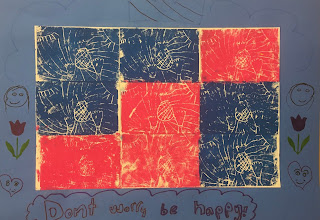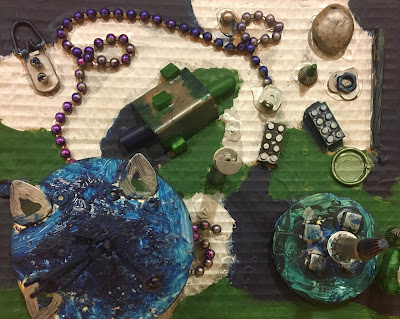Eighth graders at The Rashi School learned about Zentangles, a drawing technique that combines connected, geometric patterns to create mesmerizing compositions. They used three official Zentangles, then invented their own, focusing on dimensionality and complexity. Materials included metallic sharpie, cellophane, acetate, watercolor, and masking tape.
Wednesday, December 18, 2019
Wednesday, December 11, 2019
Seventh Grade Edible Art
Seventh graders at The Rashi School used their shading skills to create these beautiful apples in 2B pencil, colored pencil, or watercolor pencil. For several classes leading up to the project, they practiced shading spheres using these techniques. First they drew the apple, then they took a bite, then they drew... etc.!
Friday, December 6, 2019
Fourth Grade Printmaking
Fourth graders at The Rashi School learned about Tanzanian Kanga cloth, which combines patterns with messages and blessings. They created an abstract design on a foam printing plate. Then, they printed the pattern nine times to create a grid. Finally, they wrote their message or blessing on their background paper.
Tuesday, November 26, 2019
Third Grade Texture Paintings
As part of a unit on texture, third graders created these texture paintings. First, they glued found objects onto cardboard. Then, they used acrylic paint to create their colorful designs. In the introduction to this lesson, they learned about three artists: Louise Nevelson, Thornton Dial, and James Hampton.
Nevelson was an American artist who used wood and cardboard to create her sculptures. She usually painted them in one color, or monochrome:
Thornton Dial lived in the American South during segregated times. He had to drop out of school to work and help his family. In his spare time, he created sculptures from found objects.
James Hampton was a janitor in Washington, D.C. Upon his death, it was discovered that he had spent years creating a giant throne out of found objects and aluminum foil in a rented garage. Today, it's in the Smithsonian Museum!
Here are .the third grade works inspired by these artists:
Wednesday, November 13, 2019
Kindergarten Expressionist Animals
Kindergarteners observed and discussed two paintings of cows. One was realistic and one was Expressionist. We discussed how, a long time ago, people expected art to look realistic- but then artists started to take big risks and to change shapes and colors in their work. Some of these artists called themselves Expressionists, because they used color as one way of expressing their feelings through their art.
I demonstrated how to use different shapes to draw an animal, and they drew with pencil, then outlined in black paint. Finally, they used bright colors to create their Expressionist animals.
Children and a Cow, Albert Cuyp, 1640
Yellow Cow, Franz Marc, 1911
Subscribe to:
Posts (Atom)






















































